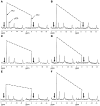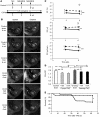Creatine kinase-mediated improvement of function in failing mouse hearts provides causal evidence the failing heart is energy starved
- PMID: 22201686
- PMCID: PMC3248286
- DOI: 10.1172/JCI57426
Creatine kinase-mediated improvement of function in failing mouse hearts provides causal evidence the failing heart is energy starved
Abstract
ATP is required for normal cardiac contractile function, and it has long been hypothesized that reduced energy delivery contributes to the contractile dysfunction of heart failure (HF). Despite experimental and clinical HF data showing reduced metabolism through cardiac creatine kinase (CK), the major myocardial energy reserve and temporal ATP buffer, a causal relationship between reduced ATP-CK metabolism and contractile dysfunction in HF has never been demonstrated. Here, we generated mice conditionally overexpressing the myofibrillar isoform of CK (CK-M) to test the hypothesis that augmenting impaired CK-related energy metabolism improves contractile function in HF. CK-M overexpression significantly increased ATP flux through CK ex vivo and in vivo but did not alter contractile function in normal mice. It also led to significantly increased contractile function at baseline and during adrenergic stimulation and increased survival after thoracic aortic constriction (TAC) surgery-induced HF. Withdrawal of CK-M overexpression after TAC resulted in a significant decline in contractile function as compared with animals in which CK-M overexpression was maintained. These observations provide direct evidence that the failing heart is "energy starved" as it relates to CK. In addition, these data identify CK as a promising therapeutic target for preventing and treating HF and possibly diseases involving energy-dependent dysfunction in other organs with temporally varying energy demands.
Figures









References
-
- Pfeffer MA, et al. Myocardial infarct size and ventricular function in rats. Circ Res. 1979;44(4):503–512. - PubMed
-
- Hunt SA, et al. 2009 focused update incorporated into the ACC/AHA 2005 Guidelines for the Diagnosis and Management of Heart Failure in Adults: a report of the American College of Cardiology Foundation/American Heart Association Task Force on Practice Guidelines: developed in collaboration with the International Society for Heart and Lung Transplantation. Circulation. 2009;119(14):e391–e479. doi: 10.1161/CIRCULATIONAHA.109.192065. - DOI - PubMed
-
- Ingwall JS. Is cardiac failure a consequence of decreased energy reserve? Circulation. 1993;87(suppl VII):VII-58–VII-62.
Publication types
MeSH terms
Substances
Grants and funding
LinkOut - more resources
Full Text Sources
Medical
Molecular Biology Databases
Research Materials
Miscellaneous

